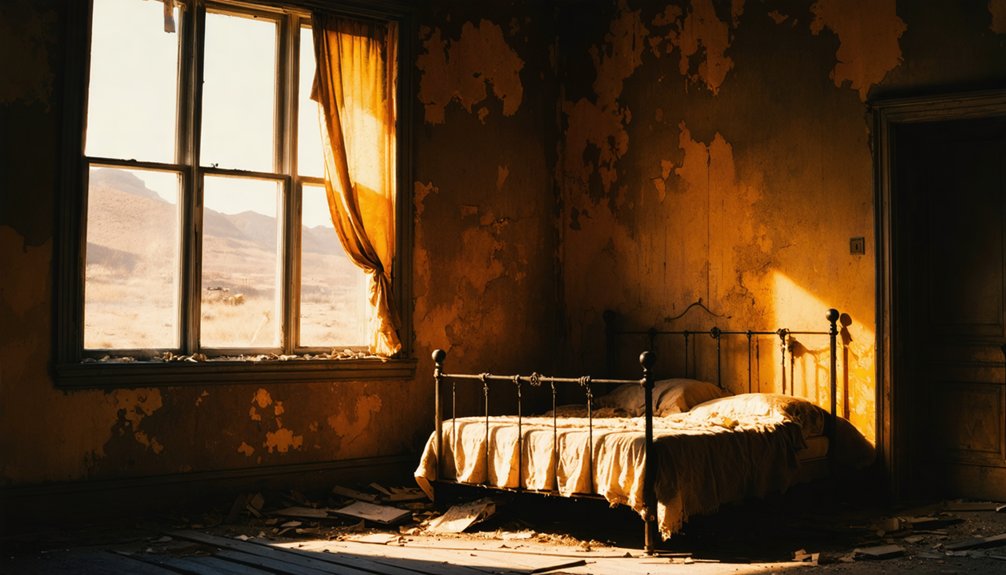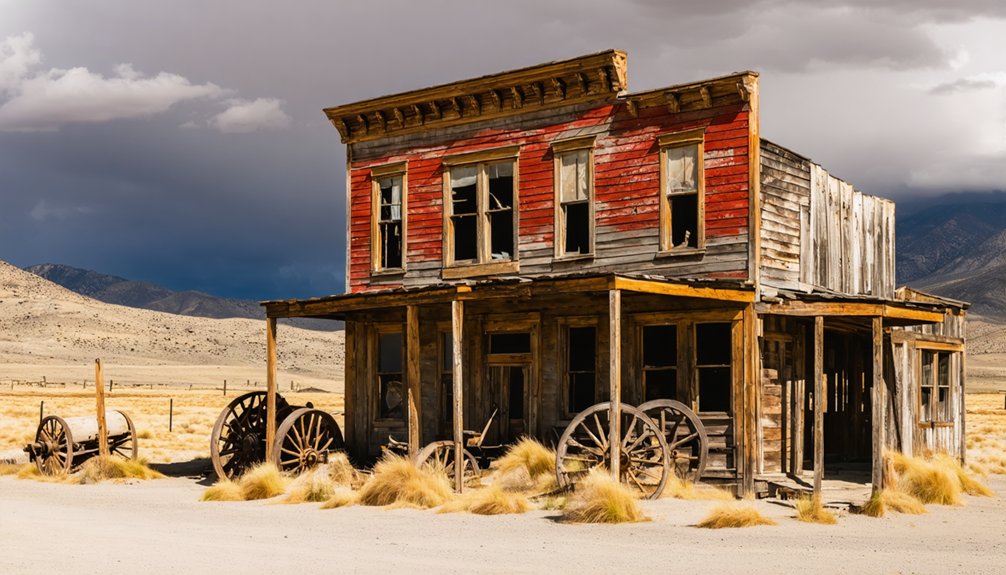Ghost towns and abandoned settlements worldwide reflect economic booms and busts, from America’s Gold Rush ruins to China’s empty metropolises. You’ll find medieval European villages left to decay after plagues and modern towns evacuated after disasters like Pripyat. These architectural time capsules preserve distinct cultural heritage while revealing humanity’s vulnerability to resource depletion, industrialization, and environmental calamities. Their crumbling facades and empty streets tell stories of prosperity, decline, and the fragile foundations of human settlement.
Key Takeaways
- Ghost towns like Bodie (California) and Kolmanskop (Namibia) illustrate boom-bust cycles triggered by resource depletion and economic shifts.
- Abandoned cities such as Pripyat (Ukraine) memorialize disasters, while medieval villages like Craco demonstrate vulnerability to natural catastrophes.
- Texas holds the highest concentration of ghost towns in America with 511 documented abandoned settlements.
- China’s modern ghost cities represent a different phenomenon with approximately 65 million vacant units despite completed infrastructure.
- Successful preservation balances historical authenticity with tourism development, as seen in Jerome, Arizona’s transformation into a cultural destination.
The Historical Significance of Deserted Settlements
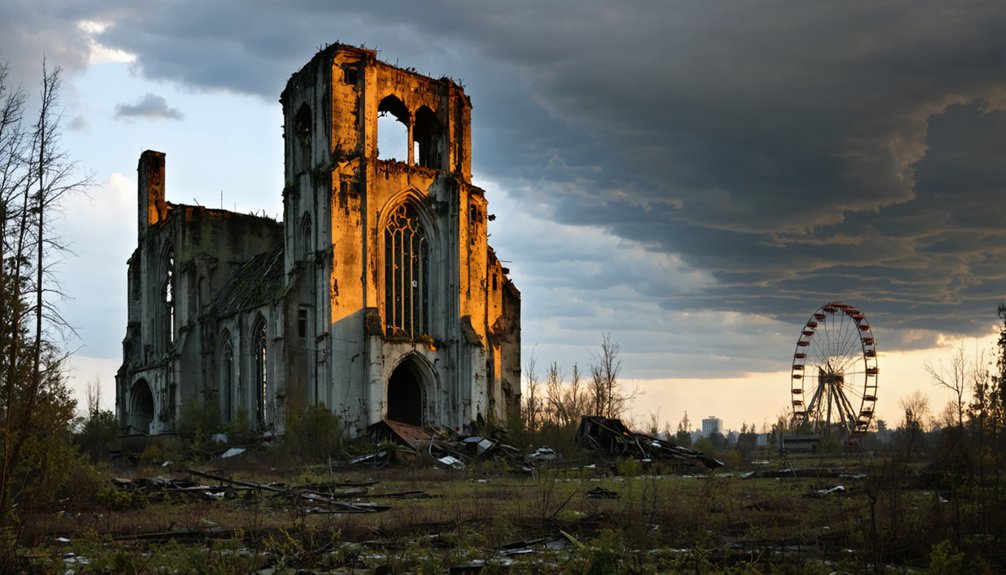
While many view abandoned settlements as mere relics of the past, they actually serve as powerful physical archives of human history, capturing moments when social, economic, and political forces dramatically altered communities.
When you walk through places like Oradour-sur-Glane or Belchite, you’re experiencing historical memory frozen in time—architectural witnesses to conflict’s devastation. These structures embody cultural identity in ways written accounts cannot.
Abandoned places speak truths no history book can—they are the silent witnesses to our collective memory.
Kolmanskop’s sand-filled German colonial buildings tell the boom-and-bust story of resource exploitation, while Pripyat’s Soviet-era apartments reveal how quickly prosperity can vanish.
Centralia’s cracked roads and endless smoke rising from the Earth serve as a chilling reminder of how industrial disasters can permanently alter landscapes.
The submerged bell tower at Lago di Resia stands as a poignant reminder of progress’s cost. As described by Lambert Florin, these places exist today as shadowy semblances of their former selves. Each abandoned settlement—whether created through political conflict, resource depletion, natural disaster, or forced displacement—offers unfiltered testimony to how fragile human establishments truly are.
American Ghost Towns: From Gold Rush to Dust Bowl
America’s vanished settlements trace a distinct arc of economic ambition and collapse, charting the nation’s westward expansion from the mid-19th to early-20th centuries.
You’ll find their skeletal remains scattered across the landscape, with Texas housing 511 documented sites—the nation’s highest concentration.
The Gold Rush (1848-1855) transformed California’s wilderness into instant cities like Bodie, where prosperity vanished as quickly as it arrived.
Mining towns across Nevada, Montana, and Utah followed similar boom-bust trajectories, leaving behind elaborate infrastructure as monuments to fleeting wealth.
Railroad towns flourished during the 1880s expansion but withered when routes changed.
Most devastating was the 1930s Dust Bowl, which emptied countless Great Plains communities across Kansas, Oklahoma, and the Dakotas, where abandoned farmhouses still stand as sentinels of agricultural collapse.
An interactive map by Geotab showcases these historic ghost towns with high-resolution photos of over 3,000 abandoned settlements nationwide.
Professor Peter Ling describes these abandoned settlements as vivid reminders of America’s turbulent past, evoking images popular in Hollywood westerns.
Japan’s Haikyo: Industrial Ruins and Abandoned Islands
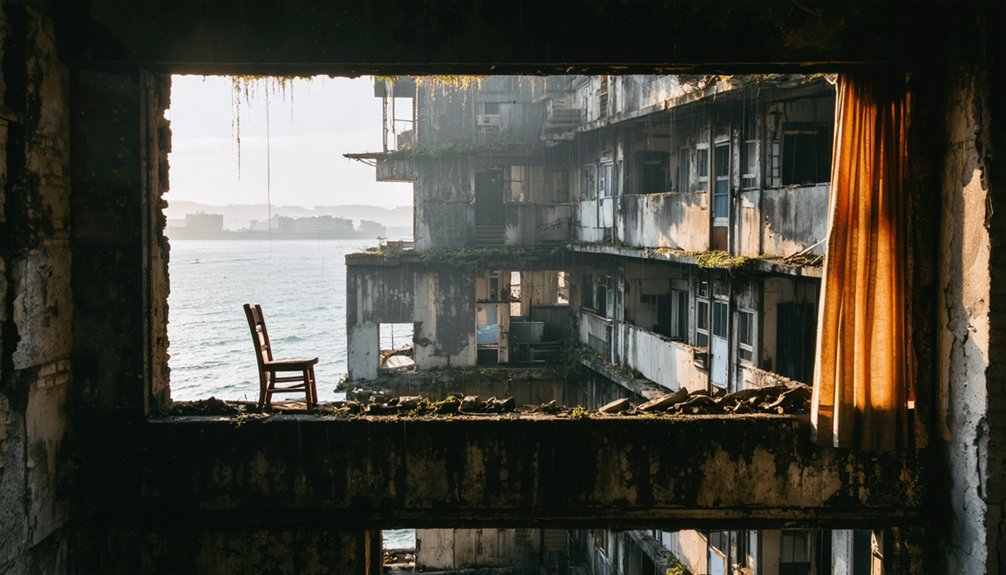
Unlike America’s ghost towns born of frontier dreams, Japan’s haikyo emerged from the nation’s meteoric post-war industrialization and subsequent economic stagnation.
You’ll find these haunting spaces—from Gunkanjima’s densely packed concrete apartments to Ashio Dozan’s decaying copper mines—frozen in moments of sudden departure.
Urban exploration of haikyo reveals Japan’s compressed economic timeline: rapid rural-to-urban migration (1960-1973), the bubble economy’s collapse, and ongoing population decline.
Japan’s abandoned spaces narrate its economic whiplash—rural exodus, financial implosion, demographic winter—all compressed within living memory.
When you walk through abandoned hospitals with scattered medical equipment or hotels with pristine lobbies, you’re witnessing the physical remnants of economic disruption. These sites symbolize the passage of time, transforming from bustling centers of activity to quiet monuments of decay.
These ruins embody a particular cultural nostalgia, representing not just industrial failure but compressed human stories. Photographers and explorers are drawn to these spaces seeking beauty in abandonment, finding aesthetic value in places others have forgotten.
In a society that favors renewal over preservation, haikyo offer rare windows into vanished pasts—concrete testimonies to ambition, excess, and ultimately, impermanence.
Europe’s Medieval Ghost Villages and War-Torn Towns
Scattered across Europe’s bucolic countryside, medieval ghost villages and war-torn towns tell a complex story of abandonment spanning centuries rather than decades.
You’ll find Wharram Percy’s skeletal remains, deserted in the 1500s when villagers were forcibly removed for sheep farming, while Craco’s eighth-century medieval architecture clings precariously to Italian hillsides, surrendered to landslides by the 1960s.
War’s destructive legacy haunts sites like Oradour-sur-Glane, where Nazi atrocities left 642 dead in 1944. These ruins stand as solemn war memorials, frozen in time. The village remains preserved as a memorial with ghostly remains and a museum displaying relics of pre-atrocity life.
Similarly, Belchite’s bombed-out structures memorialize Spain’s Civil War brutality.
Environmental challenges claimed other settlements—Poggioreale succumbed to earthquake damage, while Tyneham’s residents never returned after military requisition.
These abandoned places reveal how economic shifts, natural disasters, and political upheavals continually reshape human geography. Visitors can begin their journey to these haunting destinations from Barcelona, utilizing Aerobús services for convenient airport transport before venturing to these historical sites.
China’s Empty Metropolises: The Phenomenon of Unoccupied Urban Development
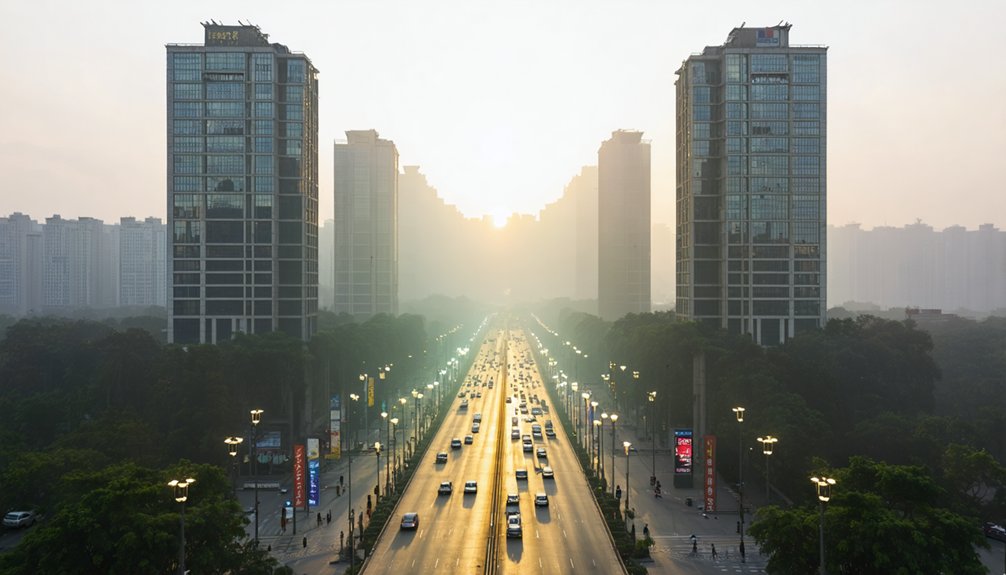
Perhaps nowhere else on Earth can you witness the stark paradox of China’s empty metropolises—gleaming skyscrapers, pristine boulevards, and modern amenities standing in eerie silence without the bustling populations they were designed to house.
This manifestation of urbanization challenges has created approximately 65 million vacant units, enough to house France’s entire population.
The housing oversupply crisis reveals itself through:
- Price collapse – Values plummeting 95% in some areas from 12,000 to 600 yuan per square meter
- Ghost infrastructure – Over 50 empty cities with completed amenities but minimal inhabitants
- Developer defaults – 77 property companies failing since 2020, with 30 delisted from markets
- Wealth vulnerability – 70% of Chinese household wealth tied to this unstable real estate market
Century Dream City in GuangDong stands as a testament to this crisis, with billions invested in development now reduced to a wasteland of vacancies.
Cities like Ordos-Kangbashi were built during coal booms but attracted only a fraction of their intended populations despite government relocation efforts.
Disaster Zones: Nuclear Accidents and Environmental Catastrophes
When nuclear disasters and environmental catastrophes strike, they transform thriving communities into modern ghost towns overnight, leaving behind architectural time capsules that reveal the moment of abandonment.
From Chernobyl’s hastily evacuated Pripyat to Fukushima’s frozen-in-time homes, these sites offer sobering lessons in nuclear safety and disaster preparedness. You’ll find Soviet-era posters alongside children’s toys—each object documenting the sudden exodus.
Environmental recovery progresses unevenly; while Jeffrey City’s population plummeted from 4,500 to just 58, pockets of community resilience persist in radiation exposure zones, with some Tatars remaining near Chernobyl despite evacuation orders.
These spaces balance between urban decay and historical preservation, their abandoned vending machines and scattered personal effects maintaining cultural memory while governments restrict access to contaminated areas—physical reminders of technology’s power and vulnerability.
Economic Factors Behind Settlement Abandonment
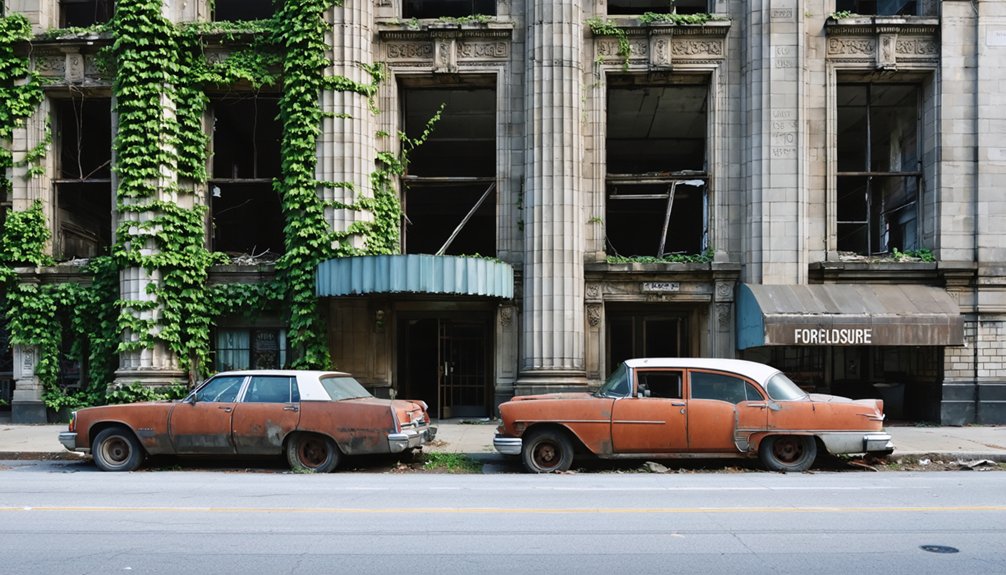
The economic architecture of abandoned settlements reveals a structural vulnerability that transcends individual choices, as prosperity’s foundation often rests on fragile resource dependencies and industrial monocultures.
When resource depletion triggers economic shifts, you’ll witness the rapid unraveling of once-thriving communities as population migration follows vanishing opportunities.
- Resource Exhaustion – The boom-bust cycle leaves behind skeletal infrastructure and plummeting property values
- Failed Urban Planning – Misaligned transportation networks and inadequate amenities isolate communities from economic currents
- Demographic Collapse – Young workers exit first, leaving aging populations unable to sustain essential services
- Financial Deterioration – Vacant properties erode tax bases, creating spiraling effects on community well-being
These abandoned spaces aren’t merely economic casualties—they’re warnings about constructing societies with insufficient adaptive capacity against inevitable change.
Ghost Towns as Cultural Heritage and Tourism Destinations
When you visit abandoned settlements today, you’re witnessing both carefully preserved historical structures and commercially reimagined spaces that balance authenticity with economic viability.
The weathered facades and crumbling infrastructures tell compelling stories of boom-and-bust cycles, revealing how communities adapted to changing socioeconomic landscapes across different eras.
These atmospheric ruins now generate significant tourism revenue for surrounding regions, transforming once-forgotten places into cultural assets that preserve collective memory while supporting modern economies.
Preservation vs. Commercialization
Throughout the haunting landscapes of abandoned settlements, a fundamental tension exists between preserving ghost towns as authentic cultural artifacts and developing them as viable tourism destinations.
The preservation challenges of structural deterioration and weather damage often collide with commercialization impacts when visitor traffic exceeds sustainable levels.
You’ll find this delicate balance manifested in four distinct approaches:
- Arrested decay protocols that maintain the hauntingly authentic feel
- Community-led conservation models employing local expertise
- Adaptive reuse of historic structures that generate revenue while preserving character
- Visitor management systems with designated pathways to protect vulnerable areas
Successful examples like Jerome, Arizona and Bodie, California demonstrate how ghost towns can avoid becoming mere tourist traps while ensuring these fragile time capsules survive for future generations to experience.
Tourism’s Economic Impacts
Despite their abandoned appearances, ghost towns across America have transformed into powerful economic engines when properly developed as tourism destinations.
You’ll witness how these historical relics generate substantial tourism revenue when preserved authentically, often doubling the spending of domestic visitors through international appeal.
When ghost towns decline, the economic impact ripples through communities.
Small businesses—from local restaurants to tour operators—suffer first, with family-owned establishments closing as visitor numbers drop.
A 17% decrease in tourism can translate to billions in lost revenue, as recently seen in major destinations.
Smart communities are diversifying beyond mere preservation, incorporating renewable energy installations and downtown revitalizations that attract regional visitors.
This balanced approach protects these fragile historical assets while sustaining the economies that now depend on their continued existence.
Storytelling Through Ruins
Ghost towns embody far more than decaying structures—they function as powerful repositories of cultural narratives waiting to be interpreted through strategic preservation efforts.
When you walk through these abandoned places, you’re experiencing history through arrested decay, where each building reveals layers of human experience and economic cycles.
- Interpretive signage in multiple languages transforms silent ruins into eloquent storytellers, as seen in Ashcroft’s bilingual presentations.
- Docent-led experiences connect you directly to the socio-economic forces that shaped these communities.
- Stabilization projects like Old Hundred Mine’s cliffside reinforcement preserve physical structures that anchor cultural narratives.
- Adaptive reuse initiatives in places like Jerome, Arizona demonstrate how ruin storytelling can breathe new economic life into abandoned spaces.
Preservation Efforts and the Future of Abandoned Communities
You’ll find preservation efforts for abandoned communities balancing competing interests between conserving original architectural elements and redeveloping structures for contemporary economic needs.
As digital archiving technologies advance, preservation teams are increasingly documenting these historically significant sites through 3D modeling and virtual reality experiences before physical deterioration becomes irreversible.
Managing the influx of tourists presents both opportunity and risk, requiring careful planning to prevent the commodification of local heritage while generating sufficient revenue to sustain ongoing conservation work.
Conservation Versus Development
When preserving abandoned communities, you’ll find a complex tension between honoring historical significance and pursuing economic development. This balancing act requires thoughtful consideration of community identity and environmental sustainability.
The transformation of derelict sites into vibrant cultural destinations can revitalize local economies while maintaining connections to the past.
- Economic Revitalization – Rehabilitated sites like Bodie, California attract 200,000 annual visitors, creating sustainable revenue streams
- Land Value Conflicts – Valuable real estate occupied by historic ruins often faces development pressure
- Adaptive Reuse – Successful preservation projects repurpose structures while respecting their historical integrity
- Ecological Integration – Conservation efforts must consider the delicate ecosystems that have reclaimed abandoned spaces
You’re witnessing not just architectural preservation but the safeguarding of cultural memory against the relentless march of profit-driven development.
Digital Archiving Initiatives
While ancient ruins once required physical exploration to document their existence, digital archiving initiatives now preserve abandoned communities with unprecedented fidelity and accessibility.
You’ll find technologies like 3D modeling, photogrammetry, and immersive AR/VR creating non-destructive records that let you virtually inhabit spaces lost to time.
The most promising preservation models emphasize community engagement over institutional custodianship.
Emerging governance structures like DAOs empower descendants of abandoned places to own and monetize their digital heritage assets, fostering cultural autonomy rather than passive archiving.
Cross-disciplinary collaboration is transforming previously siloed efforts into holistic preservation networks, where anthropologists’ oral histories complement archaeologists’ site digitization.
Through these digital archiving initiatives, you’re not just viewing abandoned places—you’re connecting with lost landscapes and cultural practices that might otherwise disappear forever.
Tourism Management Challenges
Tourism in abandoned communities presents a complex web of preservation challenges that stretch far beyond simple site management.
You’ll find the delicate balance between accessibility and authenticity requires innovative tourism management strategies that protect these fragile sites while supporting local economies.
- Controlled decay techniques maintain historical charm while preventing structural collapse
- Adaptive reuse initiatives transform train stations and industrial buildings into cultural hubs
- Stakeholder coordination frameworks guarantee remaining residents participate in tourism planning
- Documentation systems preserve authentic narratives often overlooked by casual tourism
When visiting these weathered monuments to bygone eras, you’re witnessing the tension between preservation and revitalization.
The most successful tourism challenges are met when local preservation societies take leadership roles, guaranteeing economic benefits flow to communities while maintaining the atmospheric qualities that make these places hauntingly special.
Frequently Asked Questions
Can People Legally Live in Abandoned Ghost Towns Today?
Crumbling facades surround you, yet ghost town laws permit residency if you’ve secured abandoned property rights through proper channels—navigating titles, zoning restrictions, and potential government buyout programs is essential for freedom-seekers.
What Dangerous Wildlife Commonly Inhabits Ghost Towns?
You’ll face wildlife encounters with rattlesnakes, mountain lions, and feral dogs in these crumbling structures. Urban predators like bats, scorpions, and toxic-affected animals thrive where humans have surrendered their domain.
Are There Underwater Ghost Towns Accessible to Divers?
Yes, you’ll find numerous underwater ghost towns ideal for dive sites. Explore submerged architectural remnants at Gad, Port Royal, and Baiae, where time has preserved socio-economic relics for your underwater exploration freedom.
Which Ghost Town Has the Most Paranormal Activity Reports?
Belchite, Spain tops paranormal hotspots with its war-frozen architecture. You’ll encounter its haunted history through crumbling structures that’ve preserved decades of supernatural phenomena, making it a freedom-seeker’s ultimate paranormal destination.
How Do Satellite Images Help Identify Undiscovered Ghost Towns?
Satellite technology lets you spot geometric patterns, foundation outlines, and road networks from above. When analyzed temporally, these images reveal urban decay signatures that urban exploration enthusiasts haven’t physically documented yet.
References
- https://vocal.media/writers/6-countries-with-the-most-deserted-cities-in-the-world-913460dpg
- https://en.wikipedia.org/wiki/List_of_ghost_towns_by_country
- https://www.guinnessworldrecords.com/news/2025/9/the-ghost-towns-at-the-edge-of-the-world-that-broke-record-titles-without-people
- https://www.losethemap.com/scariest-ghost-towns-in-the-world/
- https://www.geotab.com/ghost-towns/
- https://worldpopulationreview.com/world-city-rankings/abandoned-cities
- https://pg.world/articles/abandoned_places_part_1
- https://en.wikipedia.org/wiki/Ghost_town
- https://www.afar.com/magazine/beautiful-abandoned-places-around-the-world-that-you-can-actually-visit
- https://www.loveexploring.com/gallerylist/101630/the-worlds-most-eerie-abandoned-towns-and-cities


